You are using an out of date browser. It may not display this or other websites correctly.
You should upgrade or use an alternative browser.
You should upgrade or use an alternative browser.
Reviews by Smirk 24
Filters
Show only:
Loading…
Smirk 24
500+ Head-Fier
Pros: World-class treble.
Great resolution, among the top in its class.
Excellent bass response.
Solid micro and macrodynamics.
Available in CIEM.
Great resolution, among the top in its class.
Excellent bass response.
Solid micro and macrodynamics.
Available in CIEM.
Cons: Female vocals can occasionally sound hollow and shouty.
Use of an energizer may not fit everyone's use case.
Use of an energizer may not fit everyone's use case.
Introduction

Earlier this year, I was at a private meet after CanJam in New York City where I was introduced to a surprisingly good prototype from a brand that I'd never heard of before.
That brand was Soranik, a Vietnamese boutique, and the buzz was surrounding its prototype that made use of MEMS drivers, a new technology that only recently started making its way into some TWS and in-ears.
After the weekend settled down, I shared my excitement and impressions of the early MEMS-3S on some forums, and to my surprise, Soranik's owner Hieu reached out and asked if I'd like to demo the finalized version.
He was kind enough to ship a new unit all the way across the world so that I could listen to and share my thoughts about the MEMS-3S in this review. A big thank you to him and Soranik for their generosity.
Now, let's talk driver specs.
The Soranik MEMS-3S used for this review was a demo unit loaned to me by Soranik for the purposes of this review.
Unboxing

The Soranik MEMS-3S is a hybrid in-ear monitor with one dynamic driver tokening the bass, and two full-ranged MEMS drivers, from xMEMS and USOUND.
The MEMS-3S is priced at $2200 USD for the universal version and $2800 for the custom version.

What's inside the box:
- A pair of MEMS-3S
- AP-0 energizer
- Stock cable with 4.4mm termination
- 4.4mm to 4.4mm interconnect
- Metal puck case
The included AP-0 energizer is needed because MEMS drivers require a constant voltage to drive unlike traditional balanced armature and dynamic drivers.
An interconnect is provided to connect your source to the energizer's input, then the MEMS-3S is plugged into the output of the energizer.
Switch the energizer on and you're good to go. Admittedly, this was a routine that was awkward at first, but one that I got used to by the second listening session.
Comfort
The 3D-printed MEMS-3S shells are very lightweight, weighing just 5 grams each. The nozzle width is 5.7mm and the length is 5.4mm, however, the shell itself extends into the ear about another 3.5mm, for a combined length of about 8.9mm.The combined length is on the longer side, but due to the smaller nozzle width and shell ergonomics, actually helped achieve a deep insert and a good seal without too much discomfort.
It's important to note that the MEMS-3S has an open-back design, which raises two concerns: 1. whether it isolates outside noise effectively, and 2. whether it leaks sound to the outside.
While the MEMS-3S isolates environmental noise very well, there is a tiny bit of sound leakage to the outside. It's not egregious, but I wouldn't recommend using it in quiet places like a work office or library.
Shell weight: 5g (each)
Nozzle width: 5.7mm
Nozzle length: 5.4mm
Sources
These are the main sources I used during the review process:- iBasso DX320MAX Ti
- CMA Eighteen Master
Even with the AP-0 energizer, the MEMS-3S required additional power to run. On both my sources, I had the volume knob at about double what I normally use for my typical listening levels.
Once I did reach my listening levels, the MEMS-3S sounded properly driven so it wasn't an issue beyond having to crank up the volume. Hieu also sent over the next iteration of his energizer, the AP-1, which was much more powerful than the AP-0.
The AP-1 has significantly more power and much lower noise than the AP-0. The AP-1 had more grip and command over the entire frequency response which resulted in an more refined listening experience overall. I found it to be a significant upgrade over the AP-0.
Sound Impressions
Lows

Measurements were taken on my personal IEC-711 clone coupler.
The bass of the MEMS-3S is tuned with a tasteful sub-bass lift and is well-extended all the way down to 20Hz. The sub-bass has a satisfying rumble with good definition and tactility. The mid-bass is also well-textured, with good bass note heft and edge definition to boot.
The bass dynamics are also very good, so I'm getting thumpy bass notes with a nice sense of slam from most tracks that call for it, especially those with healthy amounts of both sub-bass and mid-bass.
While I wouldn't consider MEMS-3S's bass strictly one of the best that I've heard, when I focus in on individual aspects of the bass, the MEMS-3S executes every single one at a high level. The MEMS-3S has an excellent, undeniably high-quality bass.
Mids

The midrange of the MEMS-3S is highly resolving and has a colored yet pleasant tone. The MEMS-3S has the ability to resolve very fine microdetails and on the prototype, the midrange was one of my favorite features.
On the production version, the tuning has undergone some minor changes. It's still very enjoyable and has all the resolving capabilities and intangible enjoyability of the prototype. However, female vocals occasionally sound a touch hollow and shouty. It's only present on a few tracks but it rears its head every now and again. Male vocals don't seem to suffer from this issue but present very slightly recessed.
Tuning nitpicks aside, on the tracks that don't trigger the problem areas, vocals are presented euphonically and with a high enjoyability factor.
The timbre of the vocals on the MEMS-3S distantly reminds me of Elysian Diva 2023's for its coloration and euphonic quality. However, that's about all they have in common, as MEMS-3S's vocals aren't nearly as forward as Diva's, and is significantly more resolving and technical.
Highs
The treble on the MEMS-3S is, in my opinion, its greatest strength. The MEMS-3S's ability to resolve treble microdetails is on par with the Annihilator 2023's, and even takes it a step further by rendering them with an uncanny realism that even the Annihilator's can't achieve.The treble quantity approaches my tolerances but doesn't push past them because the MEMS drivers imbue the treble with an EST-like ethereality. On orchestral music, the attack is extremely precise yet don't feel overly sharp. Instrument notes have a realistic timbre and weight despite the notes being slightly more overloaded on the attack than the rest of the note body.
The treble also sports impressive microdynamic control, highlighting the expressiveness of instruments like cellos, violins, and pianos. The timbre of these instruments are uncannily lifelike in terms of their weight, solidity, and pace.
Considering all of these attributes, I'm left with the fact that the MEMS-3S possesses one of the top two or three treble responses in an IEM that I've ever heard.
Detail and Imaging
The MEMS-3S has details in abundance, and impressive imaging due to the defined attack that it presents notes with. The staging feels very spacious in both width and depth, perhaps aided by its open-back design.Tonality
The MEMS-3S has a colored, euphonic tone, somewhat reminiscent of the Elysian Diva's.The MEMS-3S strikes an exquisite balance between the bass, mids, and treble. My focus doesn't feel like it's being pulled towards any particular region. Instead, it sounds like I'm getting equal amounts of bass, mids, and treble all at once, all executed at a high level.
Dynamics
The MEMS-3S has impressive microdynamic control, deftly rendering the microdynamic swings on my test tracks. The MEMS-3S has decent macrodynamics, but I found the total dynamic range about average for its price range.Shortcomings
Here are some shortcomings of the MEMS-3S:- Female vocals can occasionally sound hollow and shouty.
- Use of an energizer may not fit everyone's use case.
Strengths
Here are some strengths of the MEMS-3S:- World-class treble.
- Great resolution, among the top in its class.
- Excellent bass response.
- Solid micro and macrodynamics.
- Available in CIEM.
Intangibles

Midrange nitpicks aside, I think the MEMS-3S strikes a beautiful balance across the bass, mids, and treble. This presentation is one I wasn't used to, as most in-ears I've heard emphasize one, or sometimes two of the regions.
The thing that struck me the most was the treble quality, which was highlighted best on orchestral tracks. The MEMS-3S presents instruments with a remarkable realism that I haven't heard before in other in-ears. It captures the weight, timbre, and pace of instruments in a lifelike manner.
Comparisons
MEMS-3S Vs. Annihilator 2023

Facing off against the treble king, the MEMS-3S features a treble that's just as extended as the Annihilator's with a similar ethereal timbre. What the MEMS-3S treble does better than the Annihilator's is realism that it achieves by presenting the treble with a solidity and decay that the Annihilator's treble lacks.
On the resolution front, both sets are highly capable and resolve microdetails phenomenally, but the Annihilator does seem to have a slight edge in this area after some careful A/B.
Staging is clearly wider on the MEMS-3S, whereas I found depth and height to be comparable on both sets.
The Annihilator has a more pronounced mid-bass, though MEMS-3S's is plenty punchy as well and does it with superior texturing and weight. I found the Annihilator's mid-bass quantity to be too much on certain tracks, especially on slower, more nuanced music. In my opinion, the MEMS-3S's bass has a more tasteful tuning that should suit more genres than the Annihilator's. I also prefer the MEMS-3S's overall note weight more than the Annihilator's which often feels a little lean.
Overall, I think Annihilator is the more technical IEM, just edging out the MEMS-3S in sheer resolution and dynamics. The MEMS-3S wins some ground back with a larger stage, a more balanced tonality, and with a more realistic treble.
I think choosing between these two IEMs will come down to personal preference and some quality of life decisions, like whether you mind an open-back design and your willingness to use an energizer.
Conclusion

Every year, there only seem to be a handful of in-ears that do something truly innovative. The vast majority of new releases utilize tried-and-true but familiar driver configurations, often with some minor tuning departures from sets that have already been on the market for years.
In a copycat market, the MEMS-3S and Soranik's history of innovation feel like a breath of fresh air. The MEMS lineup isn't Soranik's first attempt at implementing exotic driver technologies either—at CanJam Singapore 2023, Soranik showcased a tribrid prototype, Basilica, which utilized a magnetostatic driver.
Despite being a small boutique, Soranik has shown that they're unafraid of pushing the envelope by utilizing the latest MEMS drivers in their designs, producing not just a great MEMS implementation, but one of the finest overall in-ears on the market in the MEMS-3S.
The MEMS-3S is for those looking for a highly technical MEMS set with a W-shaped tuning, unique coloration, and one of the finest trebles on the market. I would highly recommend the AP-1 energizer over the previous AP-0 iteration as well, to extract the most performance out of this set.
What's Next
- Next, I'll be working on a written review of the Melodic Artification Alter Ego.
- Then, I'll be taking a hiatus from written reviews to focus on building a YouTube review channel.
Last edited:
Smirk 24
500+ Head-Fier
Pros: Rich, textured bass.
Lush timbre.
Safe yet engaging tuning.
Great build, stock cable, and accessories.
Lightweight and comfortable.
Fatigue-free and genre-agnostic.
Lush timbre.
Safe yet engaging tuning.
Great build, stock cable, and accessories.
Lightweight and comfortable.
Fatigue-free and genre-agnostic.
Cons: Could be more resolving and incisive.
May lack some treble vibrance for some.
Some may find the tuning too safe.
Minor bass boom/wooliness.
May lack some treble vibrance for some.
Some may find the tuning too safe.
Minor bass boom/wooliness.
Introduction

If you haven't heard of Nightjar Acoustics and the man behind it by now, now's a good time to get to know them.
Based in Singapore, Nightjar is arguably one of the best in-ear cable brands at the moment and is behind the cables for the renowned Subtonic STORM.
Chang, Nightjar's sole proprietor, is also part of the Subtonic team and it's in large part due to his passion and expertise that both Subtonic and Nightjar are flourishing.
Despite Nightjar's success, its pace of innovation hasn't stagnated. A few months ago, Nightjar unveiled its first in-ear, and the subject of today's review—the Nightjar Singularity.
The Nightjar Singularity used for this review is a personal unit.
Unboxing




The Nightjar Singularity is a single dynamic driver in-ear that retails for $1,300 USD.
The unit being reviewed is the launch edition with the upgraded stock cable, the 4-wire Vanguard (stock is 2-wire), which cost an additional $390.
The launch edition, now sold out, had a limited run of 100 units. Its faceplates showcase a polished 24k gold-plated ring and it comes packaged in a handsome Nightjar-branded bamboo box.
The unboxing experience is filled with character and has a sophisticated feel. The bamboo box adds a distinct touch and it's immediately apparent that a lot of passion and attention to detail went into the unboxing experience as a whole. Major plus points to Nightjar here.
The stock cable, Vanguard, is also super premium feeling. Both the 2-wire and 4-wire variants have great ergonomics and eye-catching, quality hardware. The termination is swappable between 4.4mm, 3.5mm, and 2.5mm plugs which come included.

Inside the box is the following:
- A pair of Singularities
- Nightjar Vanguard cable (2-wire stock, 4-wire for the upgraded cable)
- Metal puck case
- 4.4mm, 3.5mm, and 2.5mm swappable plugs
- Microfiber cloth
- Warranty card
- Subtonic house and Divinus Velvet eartips
- Nightjar stickers
Comfort
The Singularity shells are small and lightweight weighing just 7 grams apiece. Its nozzles are on the shorter side, measuring 6.2mm wide and 4mm long.The smaller nozzles can be a good or a bad thing. On one hand, it shouldn't be bothersome to listeners with smaller ear canals, but achieving a good seal can be challenging.
If you can get a good seal, the Singularity is comfortable enough for all-day use making it ideal for extended listening sessions, travel, and work.
Shell weight: 7g (each)
Nozzle width: 6.2mm
Nozzle length: 4mm
Sources
These are the main sources I used during the review process:- iBasso DX320MAX Ti
- CMA Eighteen Master
- Shanling M9+
I tested Singularity using lossless files from Tidal and Pentaconn Coreir brass eartips. I elected for the Coreir brass tips because I found slightly accentuates the treble. I'll go over this in more detail in the sound impressions.
Sound Impressions
Lows
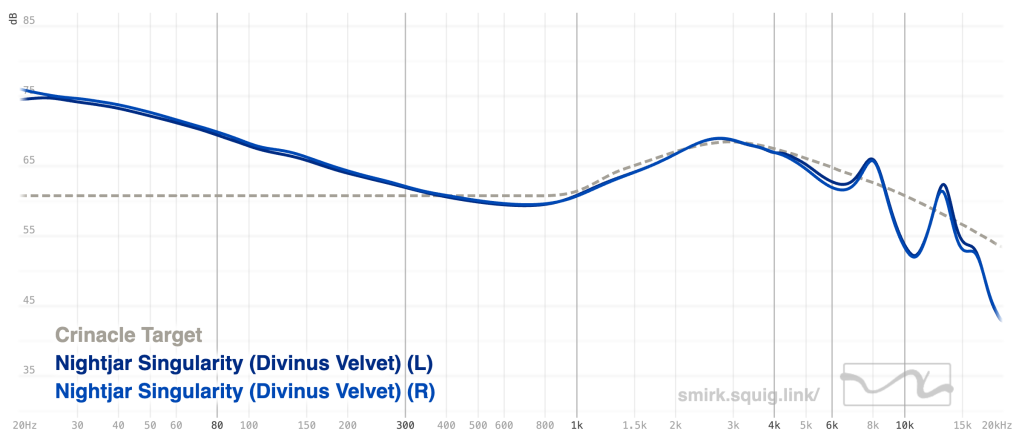
Measurements were taken on my personal IEC-711 clone coupler.
The frequency response of the Singularity is L-shaped with a well-supported midrange, and a linear, unintrusive treble that some may find a tad dark-leaning.
Pre-listen, I anticipated being overwhelmed by the lows based on the measurements and this was the case, at least initially.
After getting more listening in I realized that while the Singularity does undoubtedly have a bass-forward signature, it coalesces well with the rest of its sound. For a bass-heavy signature, the FR still manages to sounds pretty balanced which may sound like a contradiction, but trust me when I say it just works.
Singularity has great bass quality by most metrics. It extends deep and can growl and slam with authority. The bass has a good weight with a softer initial edge. It's well-textured, fairly dynamic, and has a satisfying decay and dynamic driver "bounce".
As indulgent as the bass can be, it's not without issues. Singularity's lows are characterized by a warm, thick timbre that can occasionally come across a touch boomy or wooly. I also thought the bass could benefit from more agility and definition to go along with its muscularity, as well as better edge definition.
That said, I found Singularity's bass to be well-executed overall and I think the majority of people will find it enjoyable.
Mids

Singularity's midrange is tokened by the same rich, lush timbre that permeate its lows. Both female and male vocals come across well-bodied, maybe a touch thick, especially on sources that already impart a generous note weight.
Vocals are overall pleasant but could benefit from more incisiveness and "breathiness". The midrange is fairly resolving but I felt that the perception of resolution could sound masked at times due to its thicker note weight.
Microdetails on stringed instruments like cellos and violins sounded a bit masked as well, though they had a pleasant timbre and solid microdynamics.
While sheer resolution is not the Singularity's forte, vocals and instruments in the midrange have an intangible enjoyability thanks to Singularity's excellent timbre.
Highs
The treble on the Singularity can be characterized as neutral to slightly dark-leaning. It has a defined yet slightly rounded transient attack that could use more incisiveness, and is fatigue-proof all at once.The treble is perceptibly peak-free with good extension but does have a gentle roll-off in the uppermost reaches of the treble. Due to its good extension, upper harmonics are well-captured preventing it from sounding overly dark or compromising timbre.
Overall, I found Singularity's treble to be serviceable and somewhat unremarkable. This isn't necessarily a bad thing considering many in-ears in Singularity's price range and higher are often littered with problematic peaks.
Even so, I would have liked a little more treble vibrance, airiness, and sustain. I found the treble polite and mostly complementary to Singularity's lows and mids.
Swapping to Pentaconn Coreir brass eartips helped give a subtle boost to treble presence and openness, but ultimately, Singularity's treble largely plays it safe.
Detail and Imaging
As mentioned, I don't think resolution is a strength of the Singularity. I think the resolution is pretty good for its price point but I felt that some details sounded masked due to its thicker note weight.Staging also comes across a bit intimate, though it opens up considerably on more powerful sources. Singularity scales pretty impressively as the quality of sources improve, perhaps more so than most other in-ears that I've heard.
Tonality
Singularity has a tonality that emphasizes the low end but in a way that still manages to sound cohesive and balanced.The note weight is slightly thicker than normal so I’d caution using it with sources that are already very thick and warm, like the HiBy RS6, that may push Singularity into muddy territory.
To my ears, Singularity shined the most on neutral/neutral-bright sources which I found played back most, if not all, of my music very well.
Dynamics
Singularity has solid macrodynamic and microdynamic performance for its price bracket. To illustrate this, here's a test track that I use to test microdynamics:On this track, Singularity clearly renders the microdynamic fluctuations among the string bows.
For macrodynamics, I like to use this track:
At the track's beginning, there is a gradual crescendo that begins from the onset of the two bass notes, peaking at the 2:06 mark. Then, it gets quiet again until a sudden dynamic surge at about 2:31.
The Singularity reproduces these macrodynamic swings very well. It won't give you Subtonic Storm or Annihilator-level dynamics but it's certainly not lacking in this regard.
Strengths And Shortcomings
Here are some strengths and shortcomings of the Singularity:Strengths:
- Rich, textured bass.
- Lush timbre.
- Safe yet engaging tuning.
- Great build, stock cable, and accessories.
- Lightweight and comfortable.
- Fatigue-free and genre-agnostic.
Shortcomings:
- Could be more resolving and incisive.
- May lack some treble vibrance for some.
- Some may find the tuning too safe.
- Minor bass boom/wooliness.
Intangibles
Intangibly, I find Singularity's timbre very pleasant to listen to, especially for longer sessions. Its combination of great tuning, excellent timbre, and slightly rounded transients mean that it's largely genre-agnostic and free of fatigue.The timbral and tuning qualities of Singularity are such that they won't unduly grab at you for attention, making them a good choice for more relaxed listening sessions and for work.
As a point of comparison, a set like the Annihilator that has an aggressive tuning and sound may get fatiguing or distracting quicker.
Broadly speaking, Singularity's timbre reminds me of the timbre of the 7th Acoustics Supernova which has garnered much acclaim. Both these sets sport relatively safe tunings as well.
If great timbre and competent tuning are high on your index, Singularity and the Supernova are both sets you should give some thought to.
Pro-Tip
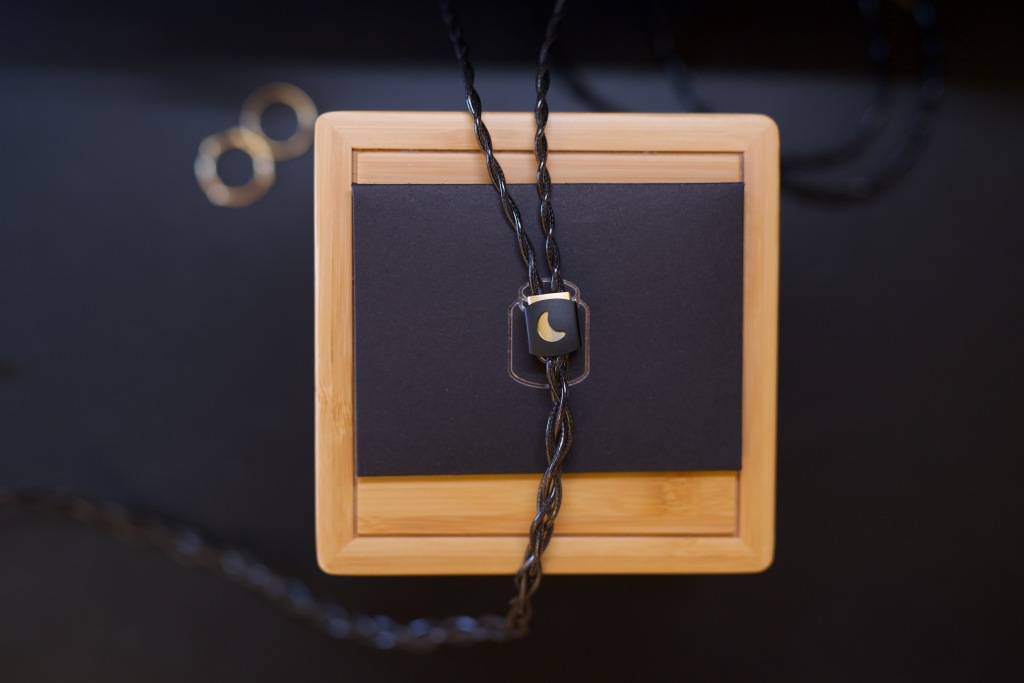
Having owned the Singularity for quite some time by now, I noticed that a lot of the timbral characteristics I mentioned originate from the stock Vanguard cable which has a creamy and smooth sound signature.
It's a very distinct sound and full of character, but if you wanted to try to achieve a tighter bass, added dynamics, or more clarity, you can always try some cable-rolling. A reason why you might try this is if you find Singularity in its stock configuration overly thick and smooth for your tastes.
Personally, I keep the stock Vanguard cable on, but I enjoy swapping cables now and again depending on my mood and playlist.
Comparisons
Monarch MK3
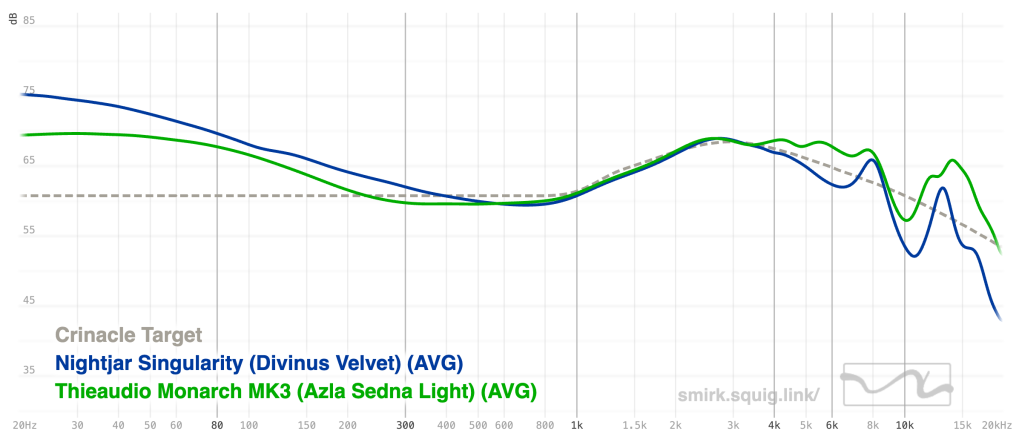
The Monarch MK3 is the successor to the immensely popular Monarch MK2, improving upon an already great product with slightly improved techs and a more engaging tuning. It is, in my opinion, one of the benchmarks at the $1k USD mark.
So, how does the Singularity stack up?
Starting with the bass, both sets have good texturing abilities and ample punch but suffer from some leading edge softness. It's been some time since I've heard the Monarch MK3 but I remember its transient edge feeling slightly bloated as well. I think Singularity's bass does a better job with feeling coherent with the rest of the frequency spectrum, whereas the Monarch MK3's feels a little more disjointed in comparison.
The midrange on the Monarch MK3 sounds more forward compared to Singularity's. Both sets have a nice midrange timbre, the Monarch's sounding sweeter and euphonic, and the Singularity's sounding thicker and honeyed. I hear the Monarch's midrange to be slightly more resolving with a more natural vocal decay, whereas Singularity's vocal decay seems to end prematurely.
The treble region of the Monarch MK3 is what I'd consider to be slightly elevated compared to neutral. It's resolving but plagued by a sense of forced detail, etch, and tizziness. On the other hand, Singularity's treble tuning is more neutral and reserved than the Monarch's. There's still plenty of detail with decent transient definition and extension.
Overall, I think the Monarch MK3 is better on paper, possessing superior techs and better value for money, but I think Singularity is a more refined product overall due to its relative lack of tuning flaws, better coherence, and better build/accessories.
7th Acoustics Supernova
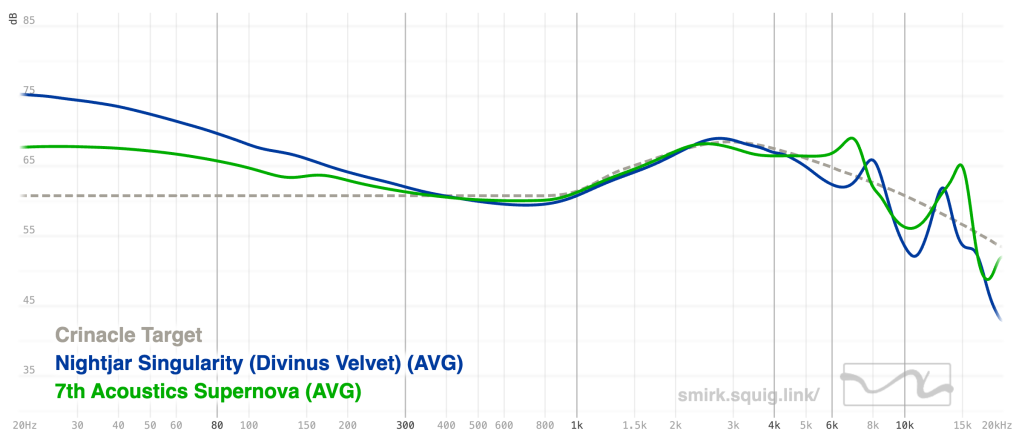
I first heard about the Supernova in Precogvision's review about a year or two ago where they were hailed as a set with near-immaculate timbre and coherency.
Since Singularity is a set that I also consider to have similar strengths, I thought these two sets would be fun to compare despite their $500 discrepancy in MSRP.
From memory, Supernova's bass had more of a mid-bass focus with good punch and bass dynamics. Singularity's bass is more balanced between sub-bass and mid-bass and slightly more textured, though its bass has a softer leading edge.
Both sets have a thicker, smooth timbre in the midrange. Supernova's vocals feel slightly recessed compared to Singularity's which sound like they're placed neither back or forward. Because of their smoothness, I see both the Supernova and Singularity as sets that can be used for hours on end with minimal fatigue.
Both sets have a mostly even, well-extended treble, with Supernova's having a touch more liveliness and sparkle compared to Singularity's.
Supernova has surprisingly good stereo imaging and sounds particularly wide. Singularity's separation and imaging are decent, if somewhat unspectacular.
Supernova's Achille's heel is its resolution which suffers from over-smoothing and some transient smearing, particularly in its midrange. Singularity isn't particularly resolving for its price either, but it does manage to be more resolving than Supernova by a decent margin.
Overall, these two sets are closer than their prices would dictate. Both sets offer some similar things, and Supernova is definitely a better value for money. But if you don't mind shelling out for a better build, stock cable, and resolution, Singularity may be worth a look.
Coming soon: comparisons to Symphonium Titan and Elysian x Effect Audio Pilgrim Noir
Conclusion

So, how does Nightjar's inaugural IEM fare against the best of the current kilobuck crop? Quite well I think.
While Singularity isn't likely to blow away those accustomed to top-tier techs around the $1-1.5k USD price range, it's an in-ear that I feel understands what it's trying to accomplish and doesn't abandon it all in the single-minded pursuit of resolution at all costs.
What Singularity is is an in-ear with a distinct Nightjar sound—a thoughtful balance of timbre, tuning, and good technicalities, all housed in a quality build, and crafted with passion and a clear vision.
All said, I think Singularity is a successful debut from Nightjar, establishing them as not only a cable company but as one of the few companies that can craft both cables and in-ears at the highest level.
Currently, Nightjar is a few prototypes into its sophomore effort, Singularity's big brother—the Duality. The latest prototype possessed the familiar Nightjar sound but with an even bigger bass and much improved techs.
It's clear that Nightjar is a company with a rising star. One that has already accomplished so much in a short span and that we can expect to keep pushing the envelope. I'll be keeping my eyes peeled for what they have in store next.
Last edited:
View previous replies…
Tanalasta
Excellent review and as always your impressions pretty much mirror mine. I haven't quite gotten over the sub/mid-bass lift of the L shaped tuning. The rest of the curve is very safe and enjoyable. There are limitations in a single dynamic driver design that a duality should be able to improve on.
Smirk 24
Thanks! I’m excited for the Duality release as well. Should be any month now 

Visceral
Great review. Selling Singularity is probably my biggest regret in the hobby thus far. I absolutely adore its tonality. I will own one again, mark my words 

Smirk 24
500+ Head-Fier
Pros: - Exceptional resolution
- World-class treble
- Great dynamics
- Fun, engaging listen
- World-class treble
- Great dynamics
- Fun, engaging listen
Cons: - Prohibitive cost
- Lack of bass texturing (for price)
- Average imaging (for price)
- Long wait time
- Lack of bass texturing (for price)
- Average imaging (for price)
- Long wait time
Introduction
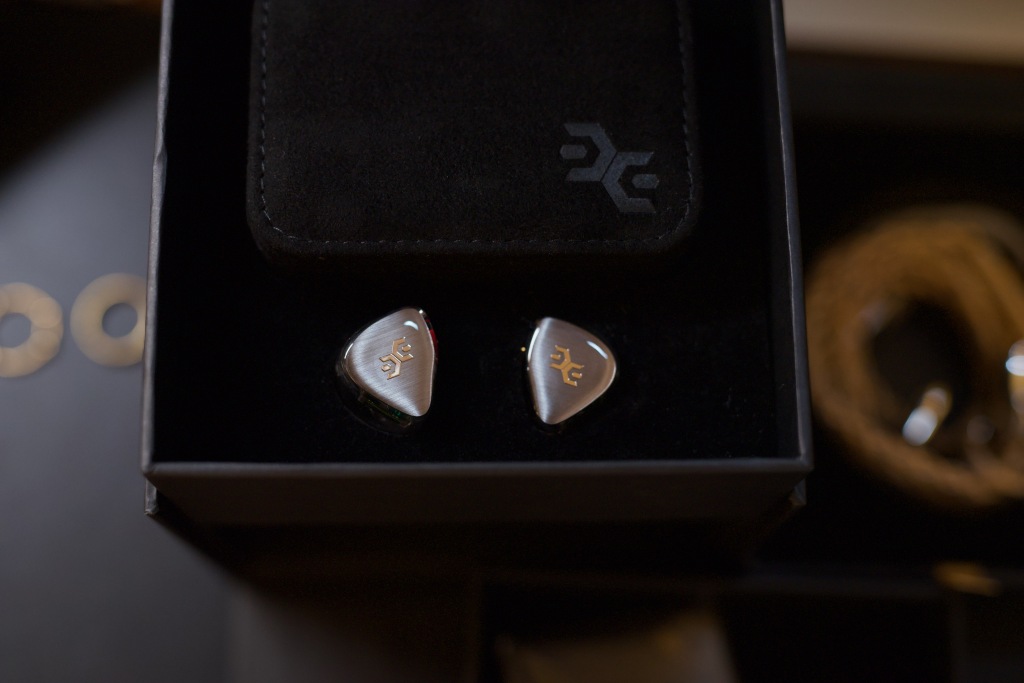
When the original Annihilator was released back in 2021, it was relegated to obscurity, that is, before word of mouth spread about how good it actually was, and how exceedingly difficult it was to get ears on a pair.
In the years that followed, the Annihilator has seen a meteoric rise to an almost unicorn-like status that it still enjoys in the present day.
The subject of today's review is the Annihilator 2023, the latest iteration, which features improvements including updates to its crossover circuit and internal wiring.
According to Lee, the internal wiring now uses different materials for each of the low, middle, and high frequencies contributing to an overall smoother presentation.
The Elysian Annihilator used for this review is a personal unit. All of my IEM reviews are reviews of personal units unless otherwise specified.
Unboxing
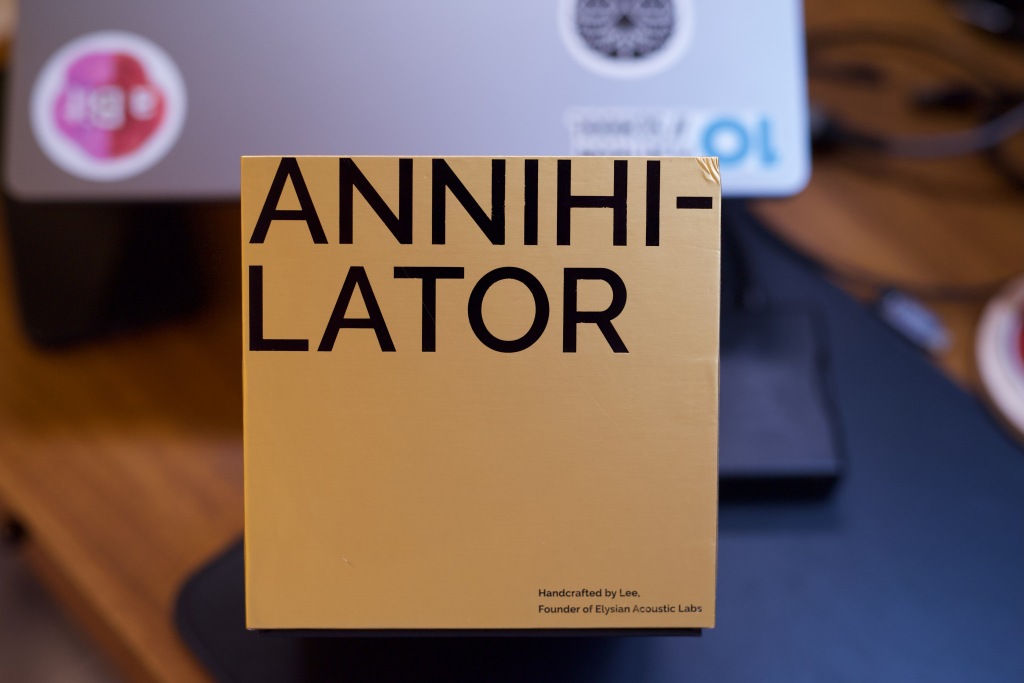
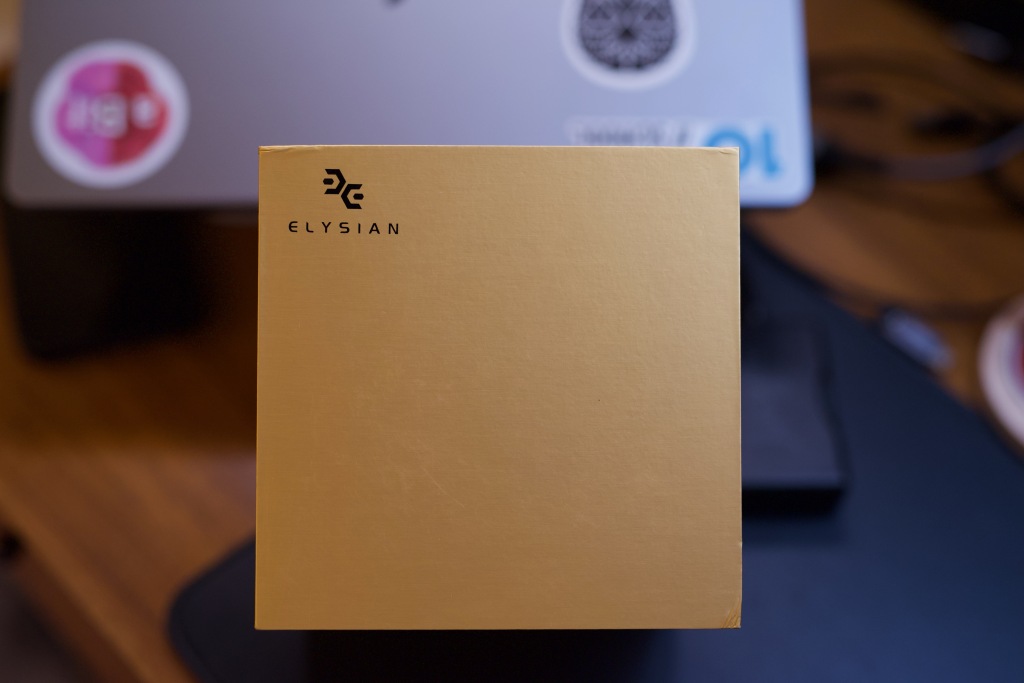
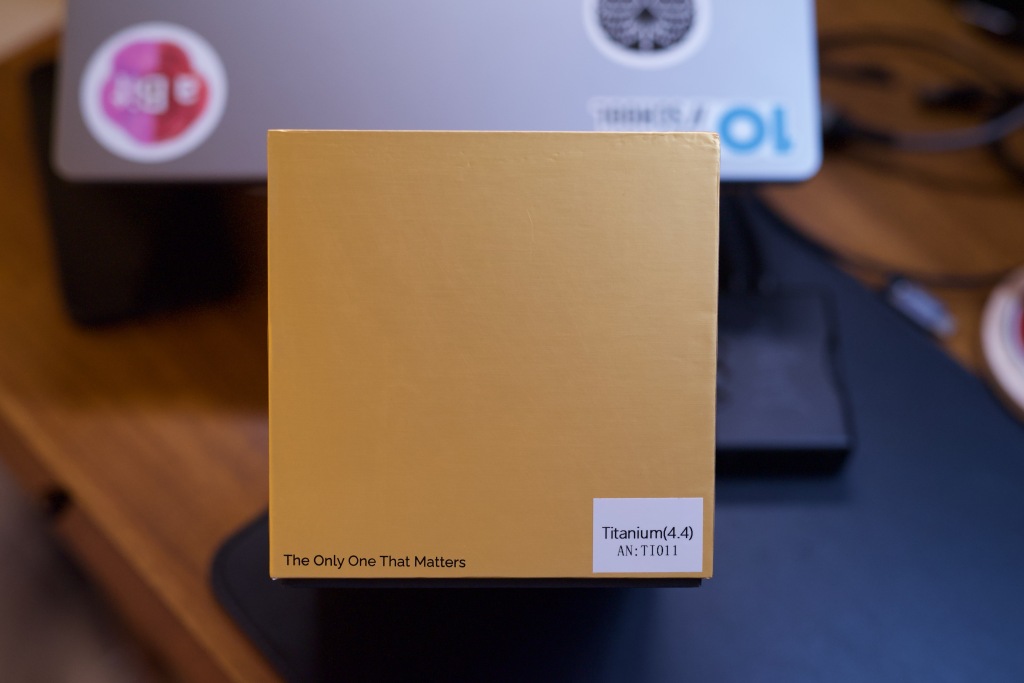
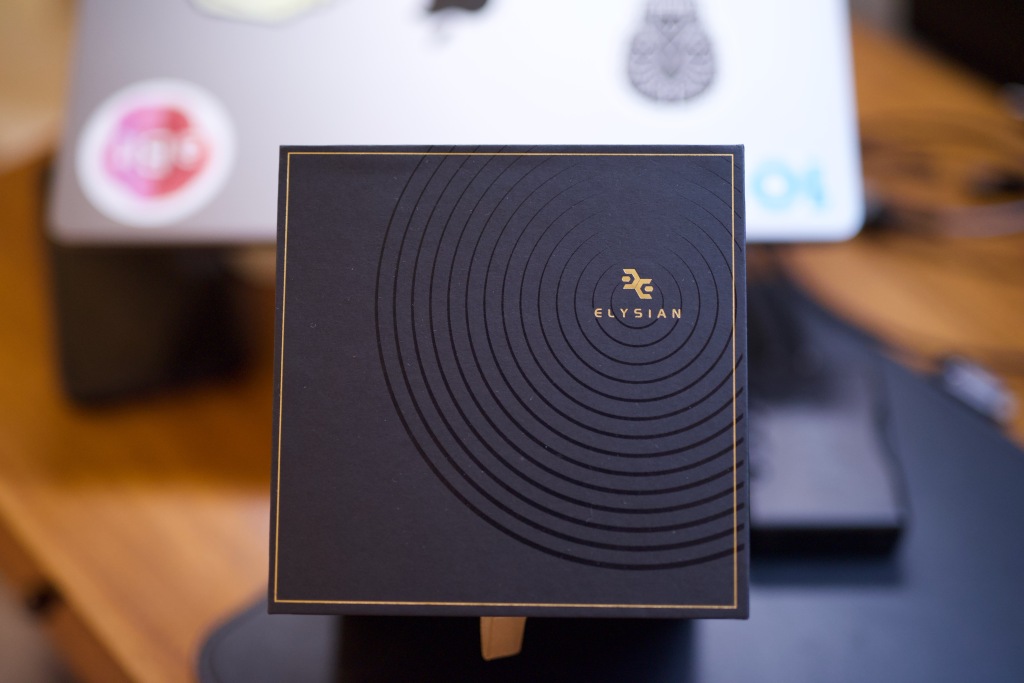
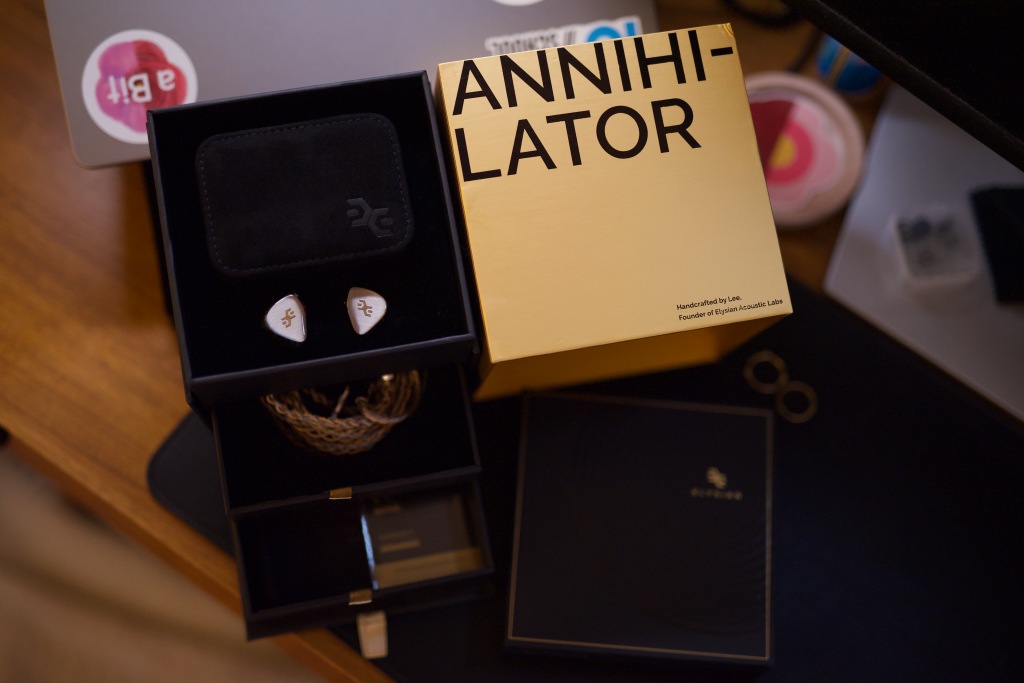
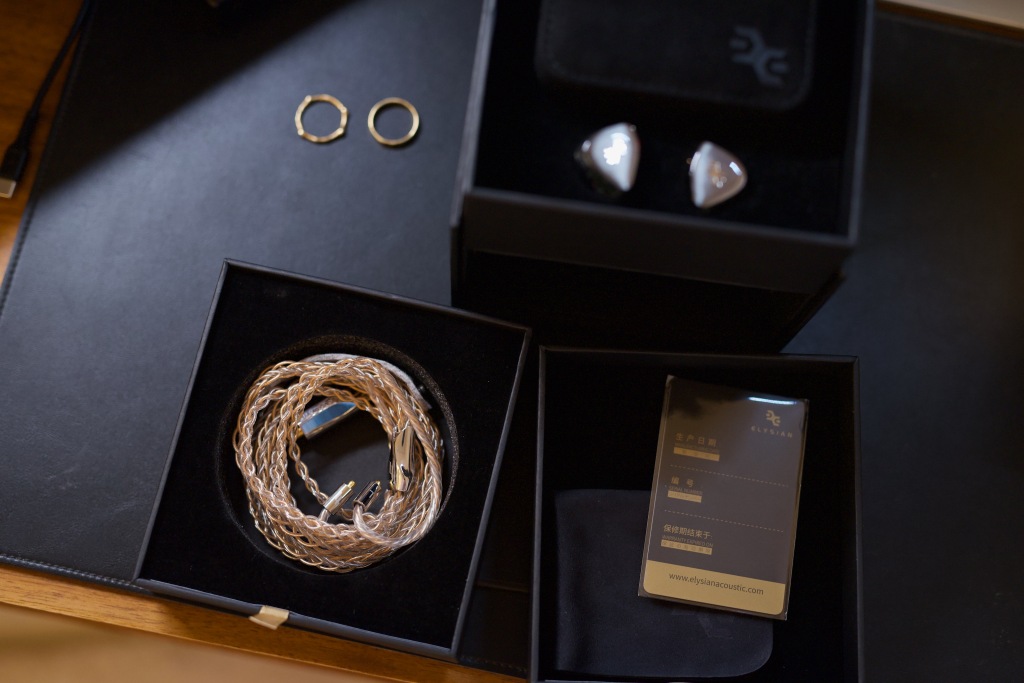
The unboxing experience of the Annihilator 2023 is extravagant.
The cubic box is enveloped in an arresting gold with "ANNIHI-LATOR" emblazoned across the face of the box in bold, all caps.
Printed on the bottom right it reads: "Handcrafted by Lee, Founder of Elysian Acoustics Labs", and there's one last inscription on the back, this time a bold proclamation: "The Only One That Matters".
Lee's flair for the dramatic is on full display with the Annihilator's packaging, and it's effective.
Sans the box cover, the unboxing experience is identical to the Diva's, only with more flair, more charisma.
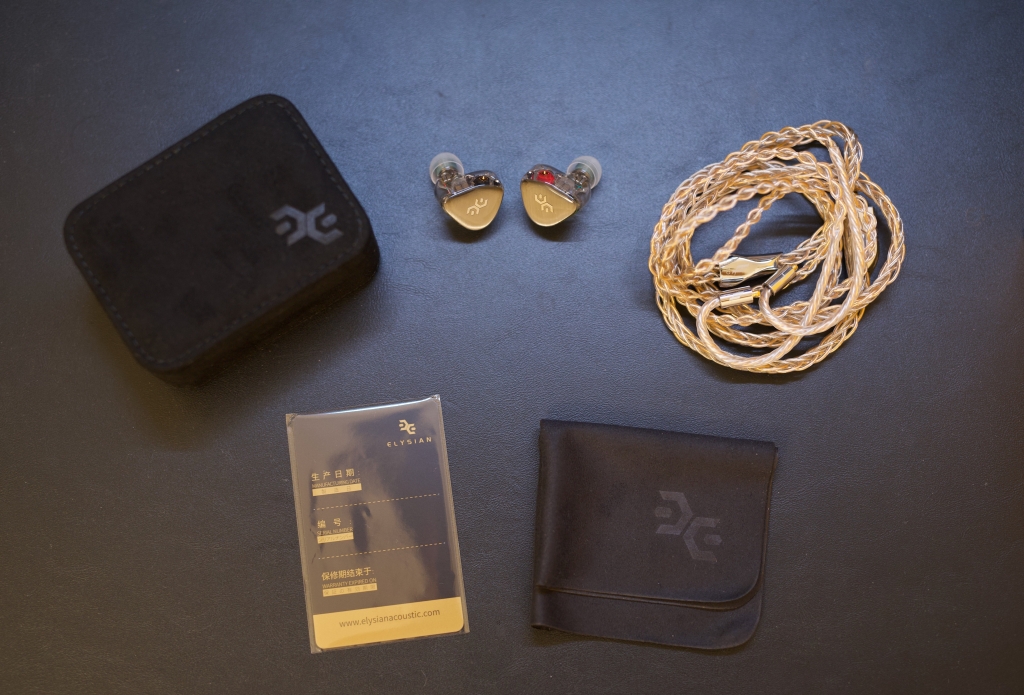
Inside the box is the following:
- A pair of Annihilators
- S/M/L SpinFit W1 ear tips
- Suede carry case
- Liquid Links Martini cable with a 4.4mm Pentaconn termination
- Microfiber cloth
- Card of authenticity
Comfort
The Annihilator shells and nozzles are on the larger side so those with smaller ear canals may experience difficulty finding a comfortable fit.Despite its larger size, the Annihilator shells are lightweight and have an ergonomic design which should help with the fit.
The stock SpinFit W1 tips have a grippy texture that helps them stay in place and create a secure seal. I'm able to wear the Annihilator for hours without discomfort, but this may not be the case for some listeners.
Fit is similar to: Elysian Diva 2023, Monarch MK2/MK3, and Blessing 2: Dusk.
Sources
I used the following sources during my review process:- MASS-Kobo 475 amp
- Chord Mojo 2
- MacBook Pro
The Annihilator is a little harder to drive than most IEMs. Despite this, I had no issues driving it on any of my sources.
I tested the Annihilator using lossless files from Qobuz, SpinFit W1 tips, and the stock Liquid Links Martini cable.
Sound Impressions
Lows
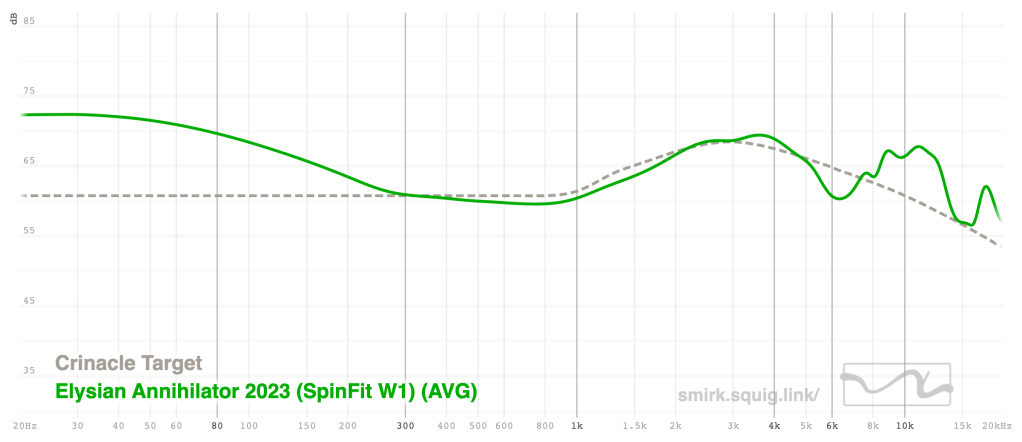
Measurements were taken on my personal IEC-711 clone coupler.
The frequency response of the Annihilator is an aggressive U-shape with a very pronounced mid and sub-bass that results in punchy lows.
The Annihilator's bass is quick and has a buzzy subwoofer-like effect with somewhat soft transient edges.
The bass is diffuse-sounding and has a large area of effect. Bass notes sound big and reverberate throughout the entire stage before quickly dissipating.
Although it’s engaging, the bass could use more finesse. It sounds as if it's on full tilt all the time and it lacks the resolution and definition found in top-tier bass responses.
The Annihilator's ability to texture bass isn't bad by any stretch but I found it lackluster for a $3000 IEM.
The bass has a decent weight, but it falls short of the sheer bass density and transient hardness of the IER-Z1R's bass. This isn't a knock since most IEMs fail to compete with the bass of the legendary Sony, but the Annihilator isn't most IEMs.
Overall, the Annihilator's bass goes for a quick, big punch and plays a complementary role to its midrange and treble. It's engaging, but it may be too much mid-bass for some listeners.
Mids
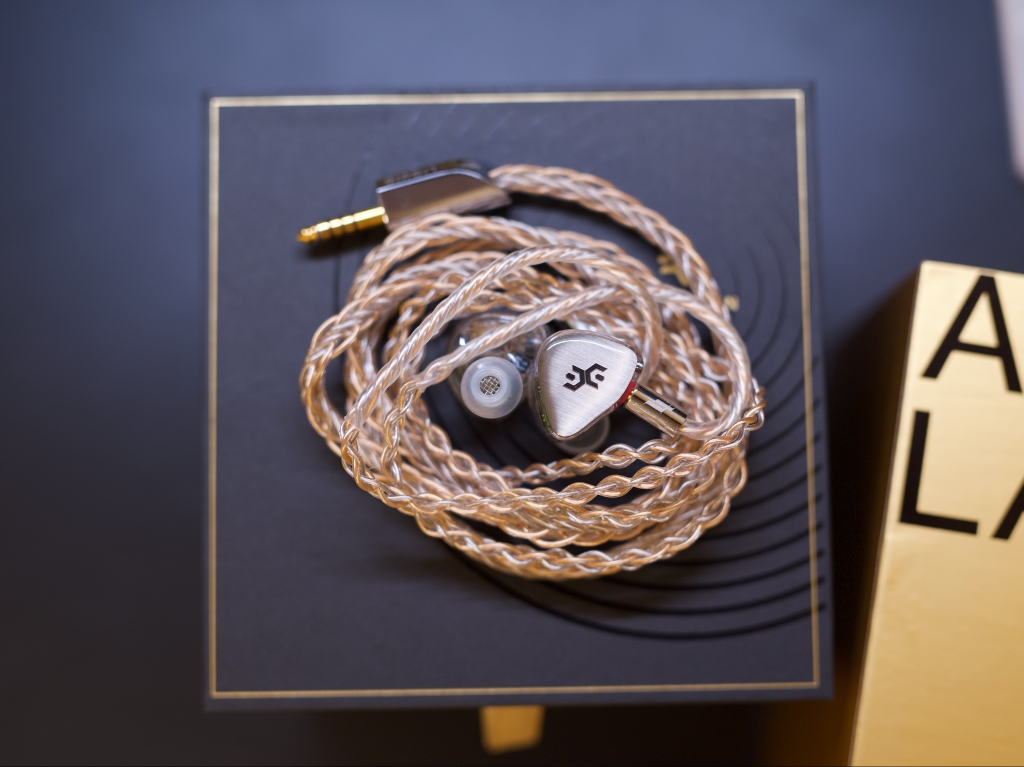
The Annihilator's midrange has a neutral-bright tonality with great clarity that comfortably bests the midrange resolution of the U12t, although the U12t does a slightly better job bringing out microdetails to the foreground.
I haven't listened to the Subtonic Storm or other contenders for the single-most resolving set period, but the Annihilator's clarity is top-tier and shouldn't leave anyone needing even more resolution.
The Annihilator's voicing is believable but ever-so-slightly raw and digital. There's a very subtle center skew in the vocal presentation that prevents it from being entirely accurate. I didn’t find this an issue though as it’s clear the Annihilator was never intended to be a reference-type IEM.
The female and male vocals are positioned forward. Female vocals can get aggressive and toe the line, but I can't say in earnest that I found them shouty on any track.
The forwardness of the midrange provides a nice balance between the aggressive mid-bass and elevated treble giving the Annihilator a slight W-shape. Considering how aggressive each section is, it's remarkable how well they interplay to provide a cohesive and engaging end result.
The Annihilator boasts a high clarity, exceptionally resolving midrange with a neutral-bright timbre.
Highs
If there’s one word that sums up the Annihilator’s treble, it’s "effortless." It's incredibly fast, and even the tiniest treble details flit in and out of existence without a single one going unaccounted for. The Annihilator’s treble is wonderfully extended and elevated, yet it never becomes sharp or piercing.Without hyperbole, the Annihilator possesses the most capable treble I've ever heard. Even during the most intensive, treble-heavy passages, the Annihilator performs as effortlessly as a world-class sprinter training at half-speed. It never seems to be under duress at any point.
It's not all praise for the Annihilator's treble though. Despite its abilities, the treble notes exhibit weightlessness and are lacking in sustain. It's almost too fast if there's such a thing.
Listening to the Annihilator's treble is undoubtedly an experience, even if it doesn't always sound natural. Even so, I think most listeners would accept this small cost in exchange for the world's best treble.
Detail and Imaging
The Annihilator's midrange and treble have superb clarity and resolution. The midrange is forward and very revealing while the treble presents all its minute details with ease. The bass is the only area where I think the Annihilator could use better definition and resolution.The Annihilator's soundstage is quite wide but has average height and depth. Imaging is pretty accurate but it's not a standout quality at $3000.
The Annihilator is easily out-imaged by the U12t and the new Symphonium Crimson which are significantly less expensive at $2000 and $1500, respectively.
Tonality
The Annihilator has a neutral-bright tonality that sounds very clean and coalesces nicely with the Annihilator's exceptional resolution.Despite its brightness, unlike other bright IEMs, the Annihilator avoids glare and sounding harsh or clinical.
Dynamics
The Annihilator has excellent dynamics that contribute to its aggressive and exciting sound. It rides large dynamic swings quickly and with ease.The Annihilator has all the components — a big bass, boosted treble, and huge dynamics — that makes it one of the most exciting IEMs on the market.
When all these elements converge at the same time on a track, it's fireworks.
Shortcomings
Here are a few shortcomings of the Annihilator:- Prohibitive cost.
- Bass definition and bass texturing could be better for its price.
- Lack of treble note weight and sustain.
- Average imaging for its price.
Intangibles
For all its celebrity, the Annihilator is hardly a perfect IEM. Despite its flaws, it has undeniable star power due to its peerless treble and allocation of strengths in high-impact areas.The Annihilator is big, bold, and loud. Sprinkle top-tier resolution and great tuning into the mix and you have a very compelling package.
In my opinion, no other IEM combines top-tier technicalities and a high engagement factor as effectively as the Annihilator.
Its combination of technique and fun is what makes the Annihilator intangibly great. Nothing sounds quite like it.
Comparisons
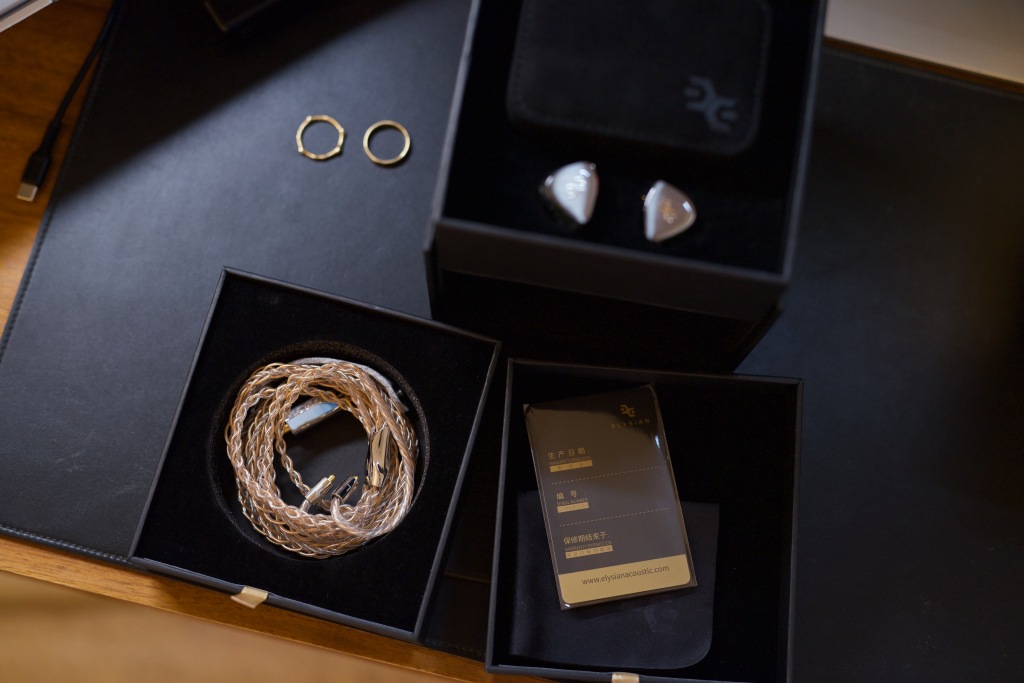
Annihilator vs. U12t
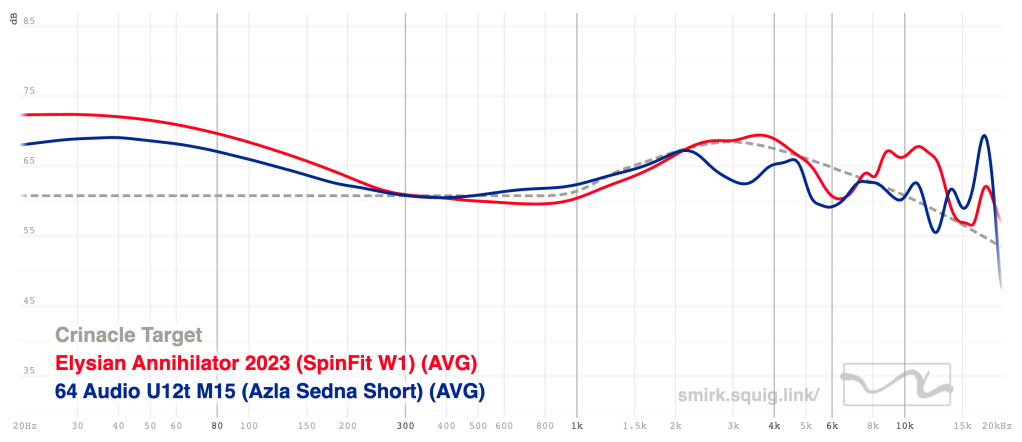
It's virtually a rite of passage for every TOTL contender to be pitted against the U12t. Let's see how the Annihilator stacks up.
The Annihilator's graph is an aggressive U, while the U12t's tuning is a bass-boosted neutral with an upper-mids scoop and an upper-treble peak.
The Annihilator has a neutral-bright tonality. The U12t's tonality is neutral-warm.
The first thing that jumps out is that the Annihilator is immediately higher-res. It is noticeably more clear in its voicing and across the frequency spectrum.
Both contenders have punchy bass, but bass texturing going to the U12t, even if it's lacking in bass realism due to its unnaturally short bass decay.
Vocals are somewhat recessed on the U12t but are smoother and more refined than the Annihilator's. The Annihilator's vocals are notably more resolving and clear.
The Annihilator's boosted treble is extremely quick and sounds pleasant despite its brightness. The U12t's treble has a more natural note weight and decay than the Annihilator's but has an upper peak that can become bothersome.
The Annihilator's presentation of music can be seen as aggressive, engaging, and opinionated, whereas the U12t's aims to create a more faithful reproduction of a recording.
Annihilator vs. Diva 2023
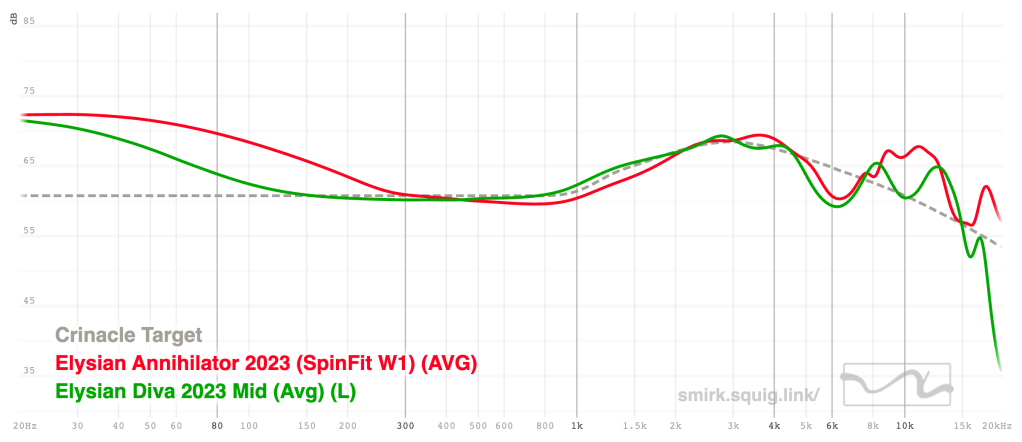
Next up we have a battle between Elysian siblings.
The younger sibling Diva has a bass-boosted neutral tuning with an upper-treble roll-off versus the Annihilator's aforementioned U shape.
The Diva has a sweet, pigmented, and at times, euphoric tonality, whereas the Annihilator's is neutral-bright.
The Diva's bass has a notable sub-bass tilt which is in stark contrast to the Annihilator's more mid-bass-focused tuning.
The bass quality is decent on both sets, but are lacking somewhat in transients, density, and texturing for their respective price ranges.
The Diva's strength is its vocal presentation which is lush, pigmented, and smooth, if ultimately lacking in microdetails and resolution. The Annihilator's vocals are slightly raw in comparison but are significantly more resolving and clear.
The Diva has a fairly linear treble with a safe tuning, though it does roll off significantly in the upper treble. Although the Diva's treble doesn't do anything wrong, it's outclassed by the superior speed, extension, and resolution of the Annihilator's treble.
The Diva and Annihilator have many differences, but they share an Elysian "house" engagement factor. No one will mistake them for reference sets, but they're undeniably moving.
Annihilator vs. Monarch MKIII
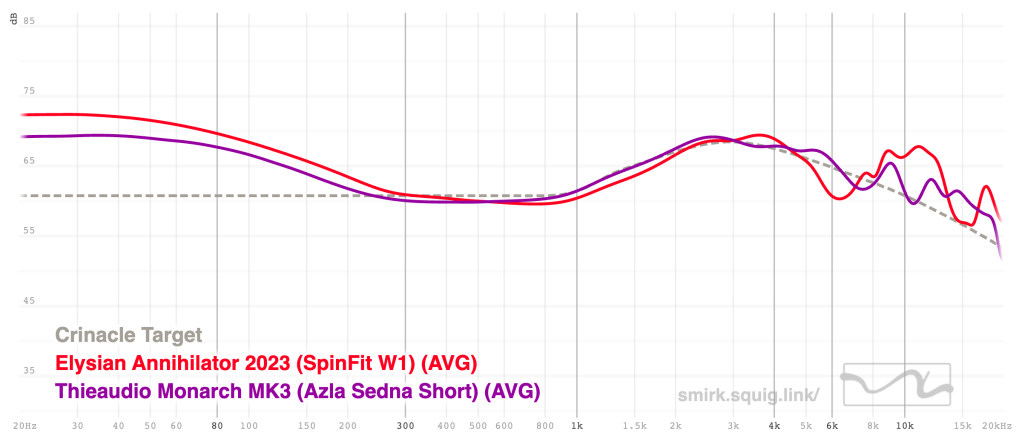
The successor to the immensely popular Monarch MK2, the Monarch MK3 is one of the newest kilobuck entries into an increasingly competitive market.
The Monarch MK3 sports a U-shaped tuning like the Annihilator and possesses great technicalities and treble extension.
Despite suffering from some mid-bass transient bloat, the Monarch has better bass texturing than the Annihilator.
The Annihilator has a slight edge in vocal clarity, but the Monarch's isn't far behind and presents a more refined vocal experience overall. Vocals on both sets present forward, with the Monarch possessing a pigmentation like the Diva's.
Although the Monarch has a well-extended treble, it suffers from some treble tizziness and an unnatural sense of treble detail. Microdetails can sound a bit forced which is in stark contrast to the effortlessness of the Annihilator's treble.
Soundstage size is competitive between the two sets, but the Monarch has a slight edge in imaging precision.
For a third of the Annihilator's price, the Monarch MK3 is a compelling product that represents great value in a rising IEM market.
Annihilator vs. Symphonium Crimson
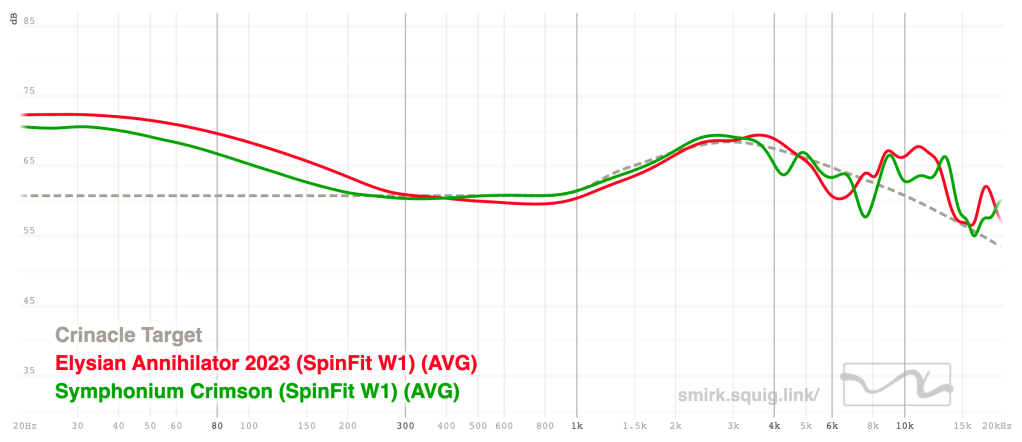
One of the newest entries into the $1600 bracket, Symphonium's sophomore offering improves upon its already well-received Helios.
Crimson is its name, and like the Annihilator, it possesses a U-shaped tuning.
You'll notice that the Annihilator's bass graphs more elevated, but in practice, the Crimson's bass has a more satisfying and pronounced slam.
The Crimson has a superb bass by virtue of its well-defined transients, substantial heft, and great texturing. It also demonstrates more nuance than the Annihilator's, filling a room or showing restraint as a recording requires.
The Annihilator's vocals present more forward than the Crimson's and offer superior clarity and resolution. Crimson's vocals are decent and sound more integrated into the mix.
Crimson's treble is well-extended but can get a little spicy because of its upper-treble elevation. I hear occasional tizziness, though this may depend on the sources and ear tips used.
The Annihilator's treble is also elevated, but it manages to sound pleasant at all times and avoids the glare and shimmer present in the Crimson's.
If the Annihilator's star quality is its treble, the Crimson's is its expansive soundstage and impeccable imaging.
Possessing a soundstage like the IER-Z1R's and imaging chops like the U12t's, the Annihilator, and most other IEMs, are outclassed by the Crimson in these areas.
The Annihilator and Crimson are two IEMs that trade heavy blows. The "better" IEM will depend heavily on the listener's preferences.
Conclusion
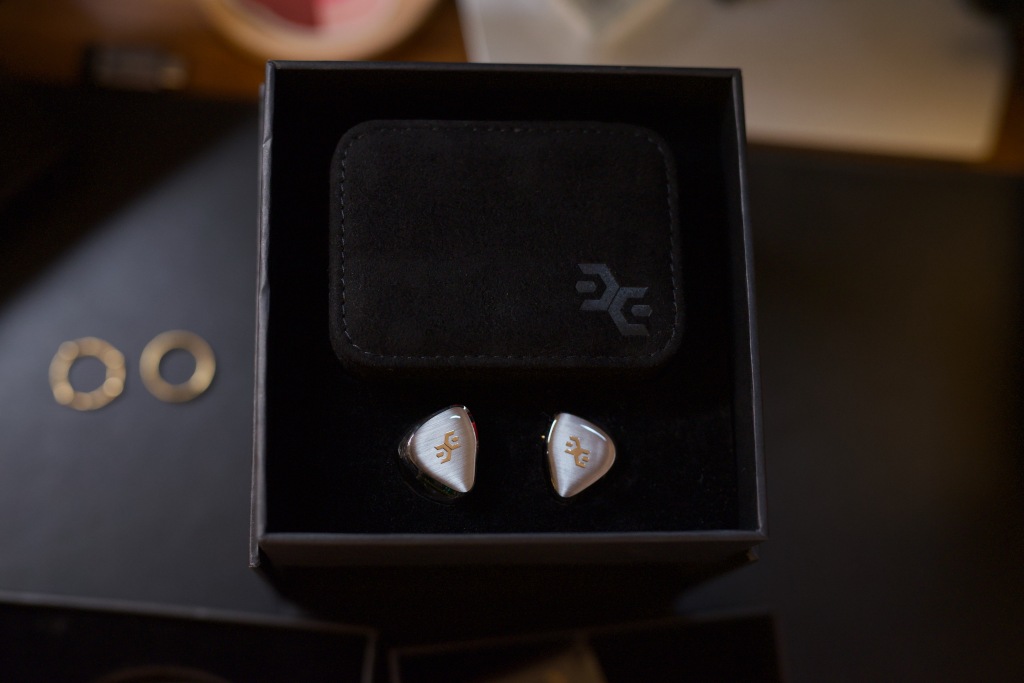
Priced at an eye-watering $3000 and plagued by lengthy production times, the Annihilator 2023 is an IEM that has a lot of promise to fulfill.
So, is it worth its astronomical price tag and agonizing wait?
I'll put it this way. If you strip the Annihilator of the shimmering robe of hype and cult-like status, what remains is a highly technical, very engaging monitor equipped with the world's finest treble.
You'd be hard-pressed to find a single IEM at or below $3000 that outright surpasses the Annihilator 2023.
Last edited:
Smirk 24
500+ Head-Fier
Pros: - Near-immaculate tonality
- Solid dynamics
- Excellent tuning
- Solid dynamics
- Excellent tuning
Cons: - Mediocre detail resolution
- 2-month lead time
- 2-month lead time
Introduction
Based out of West Java, Indonesia, 7th Acoustics is a boutique IEM brand helmed by Stephen Syn that’s been gaining popularity over the past half-year despite its limited production capabilities and long wait times.Its flagship IEM, the Supernova, has garnered acclaim from well-known reviewers Precogvision and Super* Review, particularly for its remarkable tonality.
By flagship standards, the Supernova is relatively affordable coming in at $750 – but can the Supernova compete with others in its price bracket and with current kilobuck stars?

Unboxing
The unboxing experience of the Supernova is enjoyable. It’s not as extravagant an experience as the Diva’s but it’s altogether decent.There’s a wireframe image of the Supernova on the box cover and a frequency response graph with specs printed on the back.
Underneath the box cover you’ll find a handsome chestnut-colored box with a silver 7th Acoustics logo emblazoned at the center of the box.


Flipping open the magnetic lid you’ll find a card of authenticity and the Supernovas neatly nestled inside foam cutouts. There’s a musky, perfumed scent emanating from the foam that I think was intentionally applied.
Each Supernova has unique abalone faceplates that you’ll be able to choose during the ordering process.

Here’s what comes inside the box:
- The Supernovas
- Metal puck case (threaded)
- 2-pin 0.78mm cable
- S/M/L Final E and BGVP silicone tips
- Microfiber cloth
- Card of authenticity
Comfort
The Supernova’s shells are medium-sized and protrude slightly beyond the ears when inserted. The semi-custom shells have ergonomics similar to the Variations while being even smaller and lighter in weight.The nozzles are short and have a reasonably small diameter. Suffice it to say, the fit shouldn’t pose a challenge for most people.
I should mention that the Supernovas don’t come with nozzle covers. This isn’t a negative since there are many IEMs that don’t, but if you’d like to protect your new Supernovas from earwax and other debris, you’ll have to use a stick-on mesh filter or some other method.
The Supernovas come with a good variety of ear tips, but I elected for SpinFit W1 tips for their grippiness and slightly tighter bore to eke out treble details.
Sources
I used the following sources during my review process:- Chord Mojo 2
- Chord Mojo
- HiBy FC6
- Cayin RU7
- Apple Dongle
- iPhone 13 Pro Max
Sound Impressions
Lows
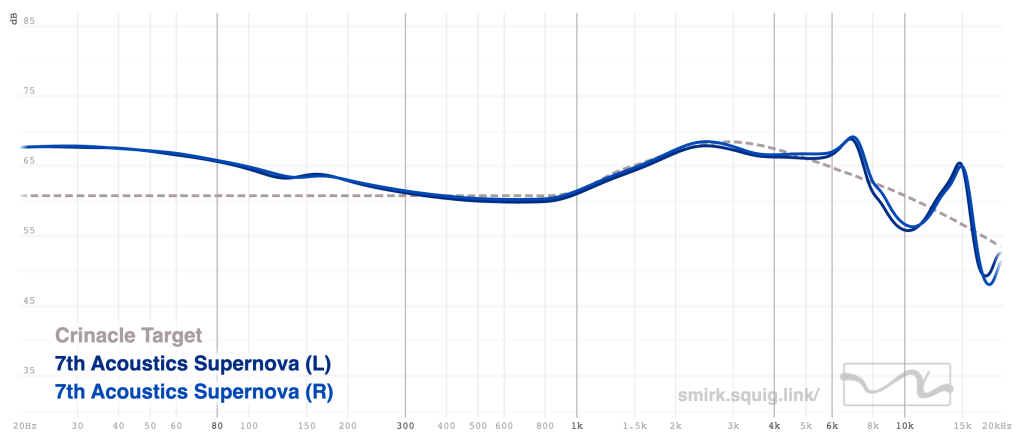
This is the frequency response of the Supernova which can be succinctly summed up as bass-boosted neutral – but not all bass-boosted neutral sound signatures are created equal.Measurements were taken on my personal IEC-711 clone coupler.
IEMs like the Variations and Diva have more of a sub-bass focus while the Supernova has a more pronounced mid-bass.
Here are their graphs with the Supernova in green:
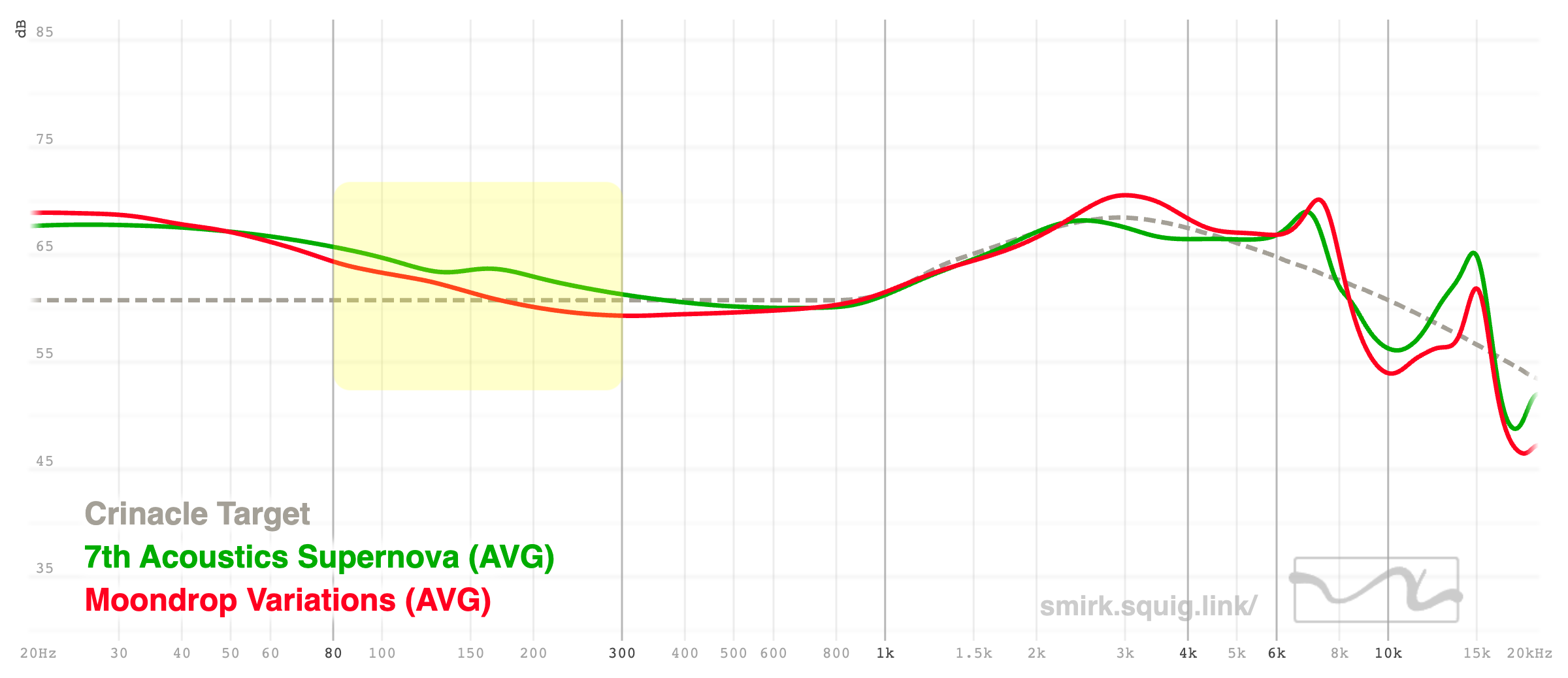
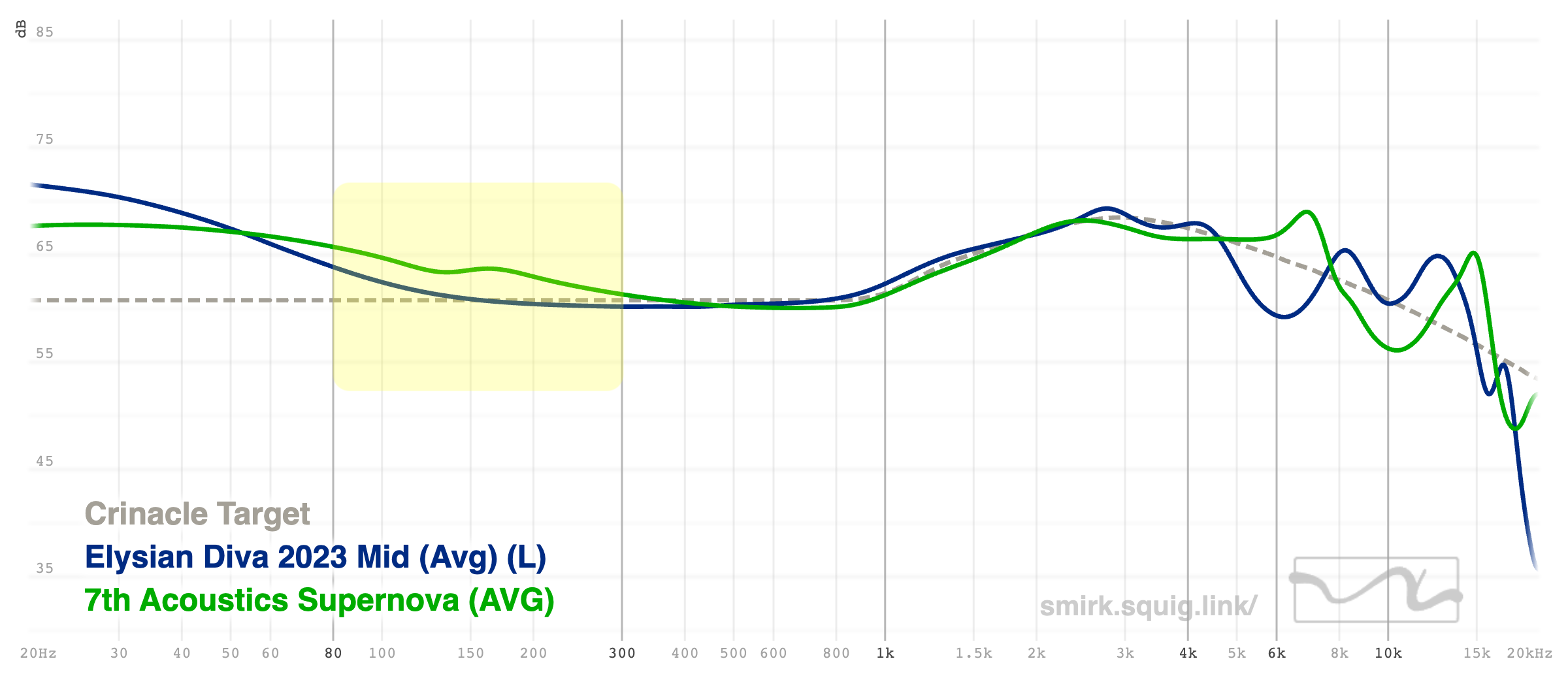
The Supernova’s bass has good body, texture, speed, and transients giving it good punchiness and tactility.
The mid-bass crosses ever-so-slightly into the lower-mids, adding an underglow of warmth to male vocals. There’s no bass bloat however, and the two regions coalesce seamlessly.
The mid-bass can compete for attention with the upper-mids depending on a track’s bass levels and vocals. This may be due to a pronounced mid-bass coupled with a relaxed ear gain, resulting in less contrast between the two regions.
For my preferences, I wish the mid-bass was about 1-2dB lower but I acknowledge that the Supernova’s bass tuning will appeal to many of you.
Mids
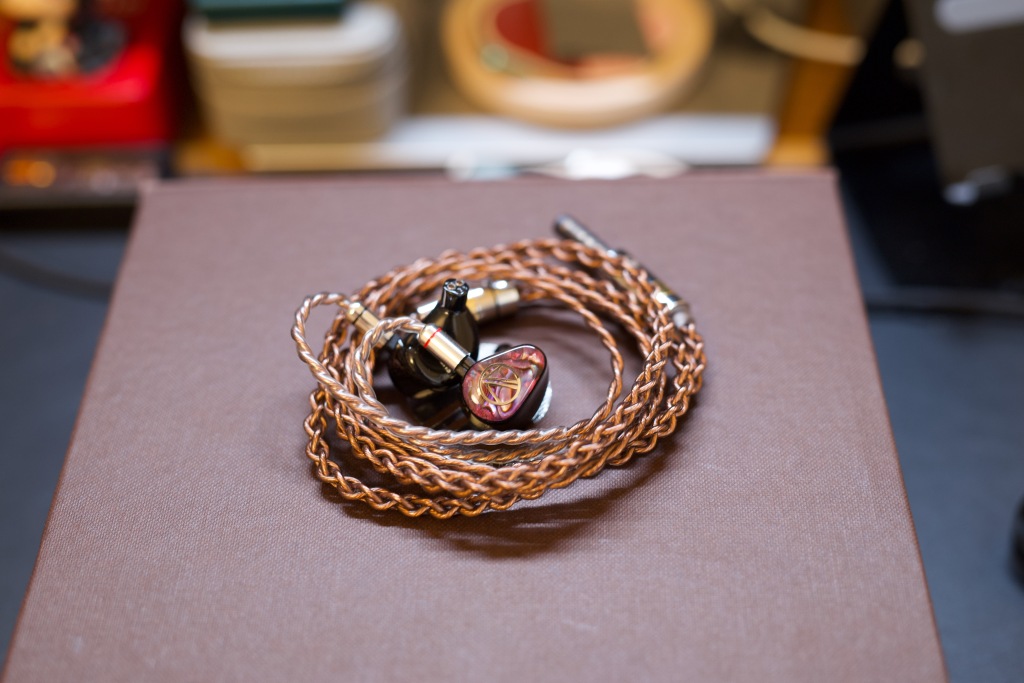
The Supernova’s standout quality is its midrange, particularly its exceptional tonality. The Supernova’s tonality has an intangible enjoyability that appears to resonate with many listeners.
Vocals are realistic, well-bodied, and smooth with a slight warmth. Male vocals are a touch forward while female vocals are a touch back because of the Supernova’s slightly relaxed upper-mids.
Despite its enjoyability, the Supernova’s midrange isn’t without flaws. I mentioned the mids are smooth, but they notably lack detail resolution and incisiveness. The Supernova resolves at a Blessing 2: Dusk, or at best, a Variations level.
Priced at $330 and $520, the Dusk and Variations fall one to two price brackets below the Supernova.
Despite its average resolution, the Supernova has the best timbre of the three and has intangibles that the Dusk and Variations don’t possess.
Highs
The Supernova has a linear-sounding treble without any egregious peaks or dips. It’s excellently tuned. Like its midrange, the Supernova’s treble timbre is on the warmer side.The treble has plenty of sparkle and never gets too sharp or uncomfortable, even in tracks with what could be glaring treble in less competently tuned IEMs.
Detail and Imaging
As I mentioned before, the Supernova isn’t the most resolving set. It’s resolving enough to not detract from music enjoyment, but you’ll be missing out on some microdetails here and there.The Supernova’s soundstage is spacious in width and height but shallower in depth. The Supernova has somewhat weak center imaging but has surprisingly accurate left and right imaging.
Interestingly, the Supernova seems to exhibit greater detail resolution on its left and right sides than compared to its center, which can contribute to the perception of better lateral imaging.
Tonality
There are some people in the community that have hailed the Supernova the “timbre king”. I wouldn’t go quite that far but there’s some truth to that claim.The Supernova has a remarkably comfortable and pleasant tonality. I’m going to draw some comparisons to another IEM whose tonality I enjoy – the Elysian Diva 2023.
The Diva’s tonality can be described as hyperpigmented, lush, and euphoric, while the Supernova’s can be described as rich, honeyed, and soothing.
Dynamics
The Supernova has noteworthy dynamics, especially for its price point. The Supernova surpasses IEMs at and below its price range, like the Variations and S8, and approaches the dynamics of kilobucks like the Symphonium Helios.Shortcomings
There’s really only one glaring issue with the Supernova – its mediocre detail resolution. It’s a missed opportunity for the Supernova to not just trade blows with, but to truly compete with the best kilobuck offerings like the Helios, Helios SE, and the U4s.Intangibles
Intangibly, the Supernova stands out for its near-immaculate tonality and great technicalities (minus detail resolution) for its price point.As it stands, the Supernova falls just short of contending with the best offerings in the kilobuck space, but this is an unfair expectation to begin with.
If the question was instead “Is the Supernova the best IEM at $750?” I would answer, “Yes, I think it is.”
On a side note, I was informed by a 7th Acoustics rep that the Supernova’s price may increase by $50 to $100 in the near future, pushing its price up between $800 and $900.
The Supernova is still class-leading around $800, but for $900 you may be better off stretching for something like the Helios or U4s.
Comparisons
Moondrop S8
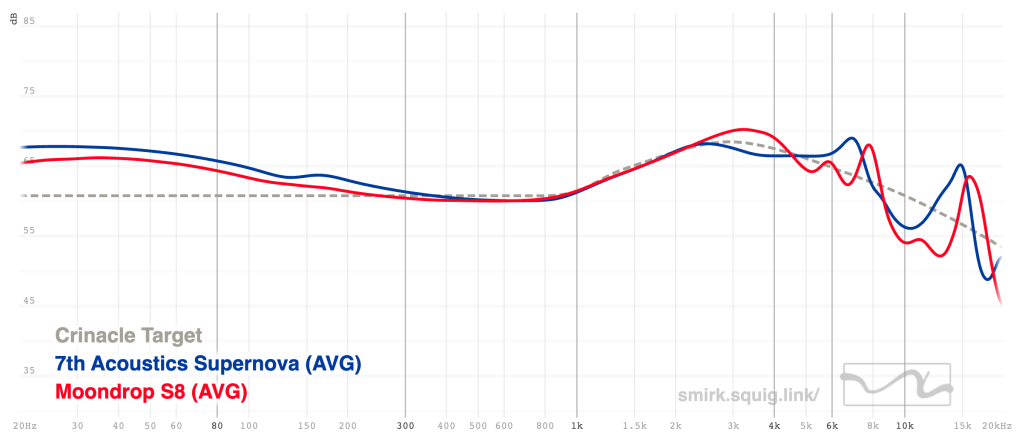
The Supernova’s main competitor is an IEM that’s almost 4 years old – the Moondrop S8.
There have been many new $700 entries since the S8’s inception but newer isn’t always better. The S8, at least to me, has remained the $700 benchmark due to its class-leading detail resolution and Harman-inspired tuning.
Like others in its class, the Supernova fails to match the S8 for detail resolution. However, the Supernova has a less fatiguing midrange and treble and possesses significantly better bass texture, density, and slam. Essentially, the Supernova is better tuned.
The Supernova has a slight upper hand in imaging and dynamics but falls far behind in detail resolution, a highly sought-after quality that the Supernova lacks and the S8 has in spades.
If you’re looking for the best overall IEM at $750, look no further than the Supernova. It has a great timbre, tuning and reasonable technicalities.
For near endgame-level detail at $700, the S8 is the only IEM that fits the bill. The S8 is also well-tuned and has a leaner and sweet tonality.
Moondrop Variations

Let’s pit the Supernova against the $500 benchmark that is the Moondrop Variations.
The Variations has a cleaner, neutral tonality and a mostly fatigue-free midrange and treble tuning.
The Variations and Supernova are both equally well-tuned so choosing one will come down to personal preferences.
Compared to the Supernova, the Variations has more forward female vocals, more recessed male vocals, and less mid-bass quantity.
The Supernova and Variations have similar detail resolution chops with the Variations edging slightly ahead. The Supernova has a wider soundstage and more precise imaging, especially to the left and right.
If you want a cleaner, neutral tonality with great tuning and sub-bass, the Variations is a great option for $250 less than the Supernova.
For those who want to experience the Supernova’s unique tonality with more mid-bass and excellent tuning, the Supernova should be your pick.
Symphonium Helios
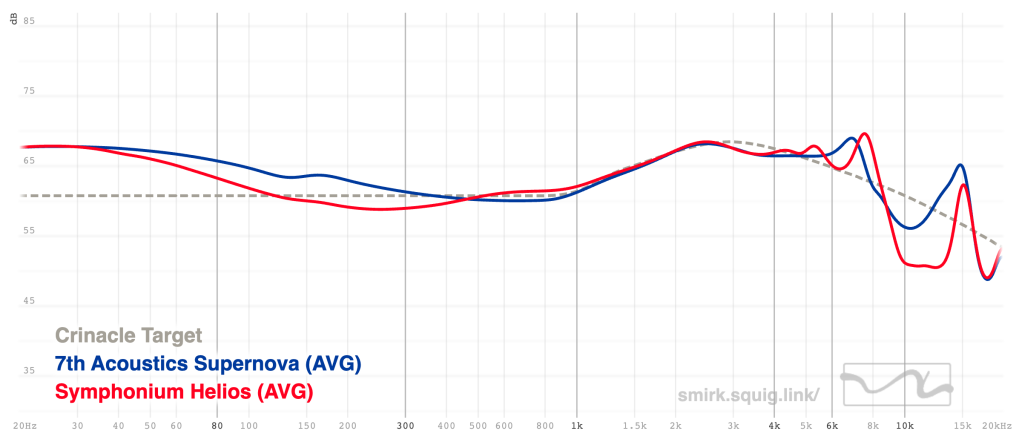
Moving up the ranks, the Symphonium Helios is a benchmark coming in at the $1100 mark.
The Helios is, first and foremost, a technical monitor. It has a neutral tonality and is more technical than the Supernova across the board.
But there are reasons to prefer the Supernova. The Supernova is priced $350 lower and possesses a better timbre with less mid-bass and lower-mids leanness.
Like the Variations, the Helios has a recessed mid-bass and lower-mids, and its timbre, especially in the mid-range, can sound overly clinical and strident. The Helios also provides an uncomfortable fit for many people.
These considerations aside, the Helios has world-class treble and great technicalities. Its incisiveness and treble are particularly suited for orchestral pieces and instrumentals.
Between the two, the Supernova is more well-rounded and is easier to listen to due to its timbre and tuning. The Helios then, is for someone that’s looking for neutrality and technicalities first.
I would be remiss without mentioning the existence of the Symphonium Helios SE, a collaboration between Symphonium and London-based Elise Audio.
It had a limited run of 50 units and addresses the Helios’ mid-bass and fit issues. I’ll release a review comparing the original and the SE in the near future.
Elysian Diva 2023
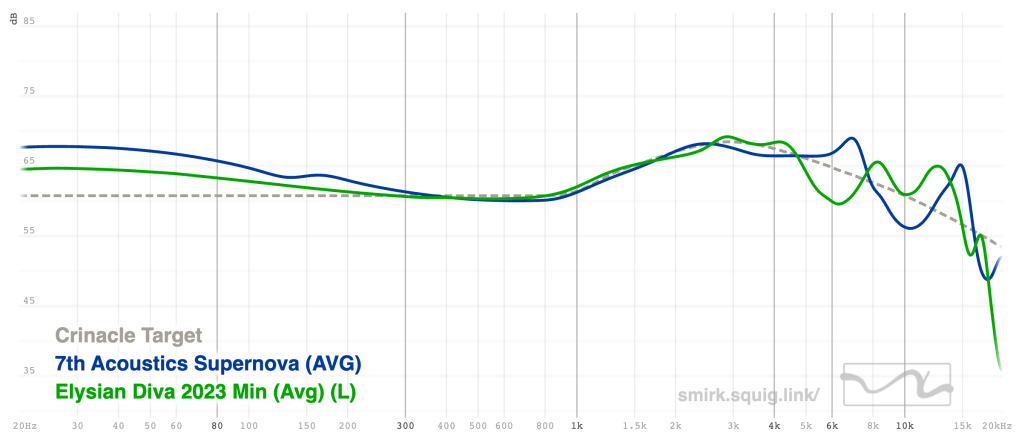

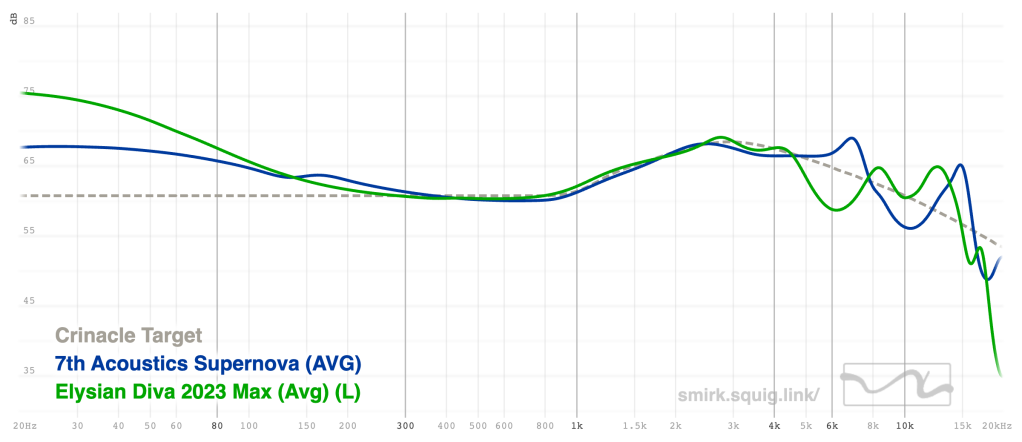
The final comparison is between the Elysian Diva and the Supernova which both do one thing very well – tonality.
The Diva’s tonality is hyperpigmented, lush, and euphoric, while the Supernova’s can be described as rich, honeyed, and soothing. Different approaches, equally excellent.
The two take different approaches to tuning as well. The Diva has greater sub-bass quantity but its bass lacks transient edges. The Supernova has more mid-bass, better transients, and slightly better bass texture as well.
The Diva’s female vocals are more forward, further emphasized by its lower treble dip, whereas the Supernova is nearly flat from its upper mids to its lower treble.
From a technicalities standpoint, the Diva is more resolving and has far better dynamics. Imaging precision, however, goes to the Supernova by a small margin.
Considering the Diva comes in at $1600 which is more than double the Supernova’s price, the Supernova holds its own pretty well.
Conclusion
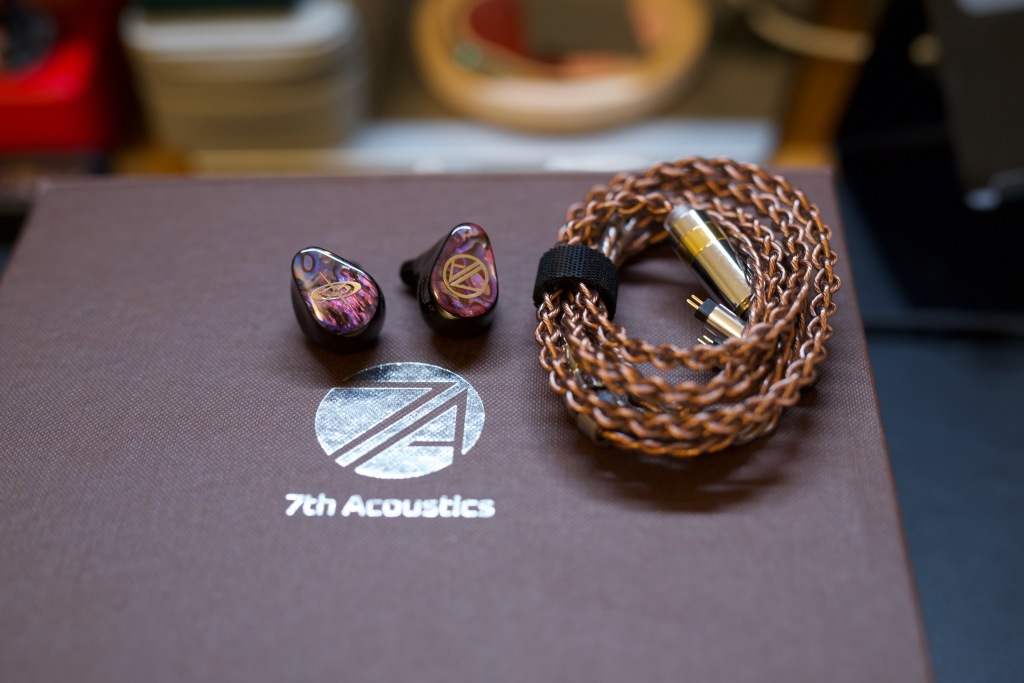
The 7th Acoustics Supernova is a remarkable entry to the $750 space that upends current frontrunners with its exceptional tuning and timbre.
The Supernova comes agonizingly close to being the unanimous pick and competing with kilobuck stars had it not been for its Achilles’ heel: lackluster detail resolution.
Still, the Supernova is a marvel at $750 that garners near-universal praise for its timbre from veteran reviewers and from yours truly.
If you have the patience to endure a 2-month lead time, the Supernova is a great all-rounder choice – just make sure you get your order in before the price jumps.
Last edited:
Smirk 24
Update: the price has jumped to $800 






